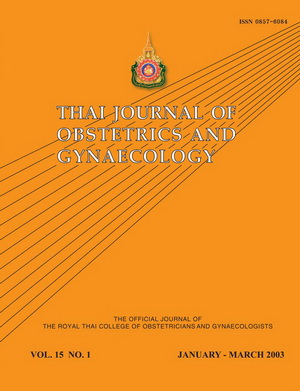Method of Placental Delivery and Postcesarean Endometritis
Main Article Content
Abstract
Objective To determine manual removal vs. spontaneous separation of placenta with cord
traction at cesarean section affects the rate of postcesarean endometritis.
Study design A randomized controlled trials, double-blinded study.
Setting Department of Obstetrics and Gynecology, Rajvithi Hospital, Bangkok, Thailand.
Subjects and Methods Pregnant women without medical and obstetric complications who
underwent cesarean section were ramdomized into 2 groups before operation. The first group
had the placenta removed manually, whereas the second group had the placenta separated
spontaneously with cord traction.
Main outcome measure Postcesarean endometritis.
Result A total of 240 term- singleton were randomized into group 1 (N=112) and group 2
(N=128). The antepartum, intrapartum and intraoperative variables were comparable in both
groups. The incidence of postcesarean endometritis was greater in the manual removal group,
12 of 112 (10.7%) than in the spontaneous separation with cord traction group, 3 of 128 (2.3%).
The relative risk was 4.57 (95% confidence interval 1.32-15.79; p = 0.007). The mean
hematocrit reduction at 24 hour postoperation were not statistically significant in both groups
(a reduction of 4.3+2.1 percent and 4.3+2.3 percent; p = 0.870).
Conclusion Manual removal of placenta in cesarean section is associated with an increase in the
incidence of postcesarean endometritis when compare to spontaneous separation. There is
no difference in hematocrit reduction postoperatively.
traction at cesarean section affects the rate of postcesarean endometritis.
Study design A randomized controlled trials, double-blinded study.
Setting Department of Obstetrics and Gynecology, Rajvithi Hospital, Bangkok, Thailand.
Subjects and Methods Pregnant women without medical and obstetric complications who
underwent cesarean section were ramdomized into 2 groups before operation. The first group
had the placenta removed manually, whereas the second group had the placenta separated
spontaneously with cord traction.
Main outcome measure Postcesarean endometritis.
Result A total of 240 term- singleton were randomized into group 1 (N=112) and group 2
(N=128). The antepartum, intrapartum and intraoperative variables were comparable in both
groups. The incidence of postcesarean endometritis was greater in the manual removal group,
12 of 112 (10.7%) than in the spontaneous separation with cord traction group, 3 of 128 (2.3%).
The relative risk was 4.57 (95% confidence interval 1.32-15.79; p = 0.007). The mean
hematocrit reduction at 24 hour postoperation were not statistically significant in both groups
(a reduction of 4.3+2.1 percent and 4.3+2.3 percent; p = 0.870).
Conclusion Manual removal of placenta in cesarean section is associated with an increase in the
incidence of postcesarean endometritis when compare to spontaneous separation. There is
no difference in hematocrit reduction postoperatively.
Article Details
How to Cite
(1)
Tangwongwan, P.; Phandhu-fung, S.; Podhipak, A. Method of Placental Delivery and Postcesarean Endometritis. Thai J Obstet Gynaecol 2017, 15, 9-14.
Section
Original Article

